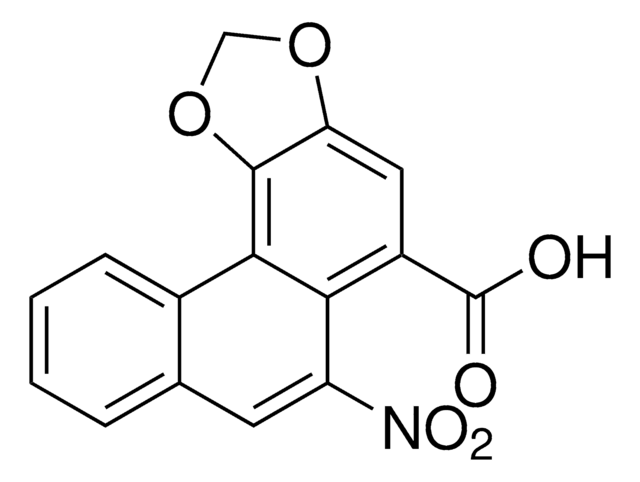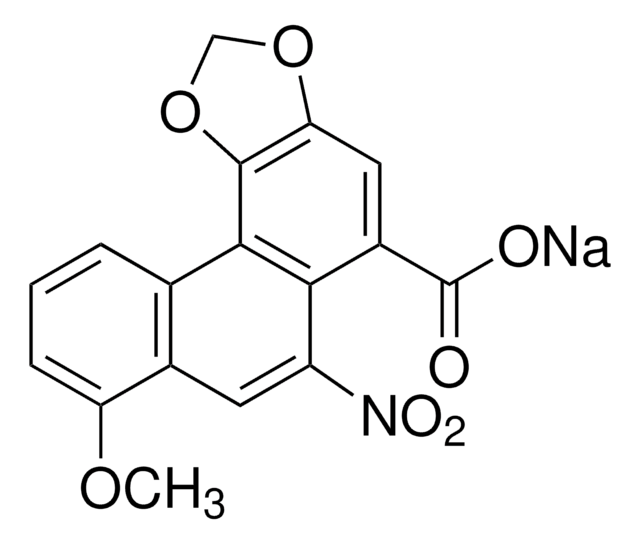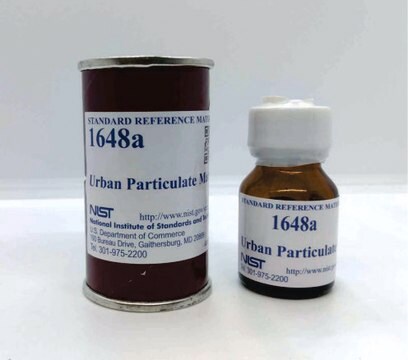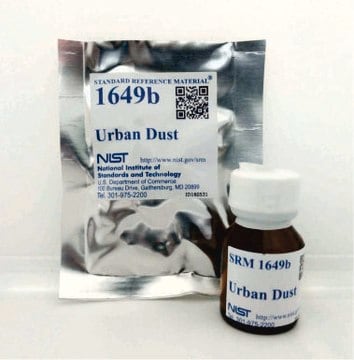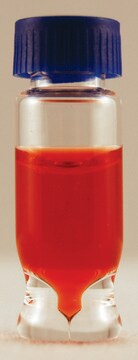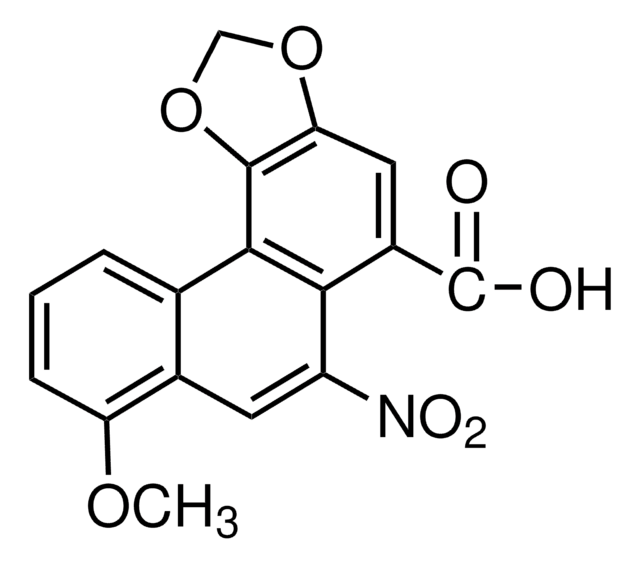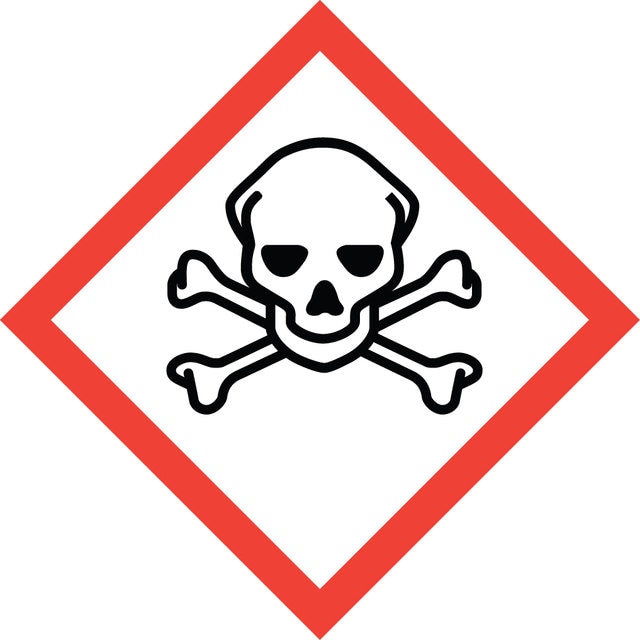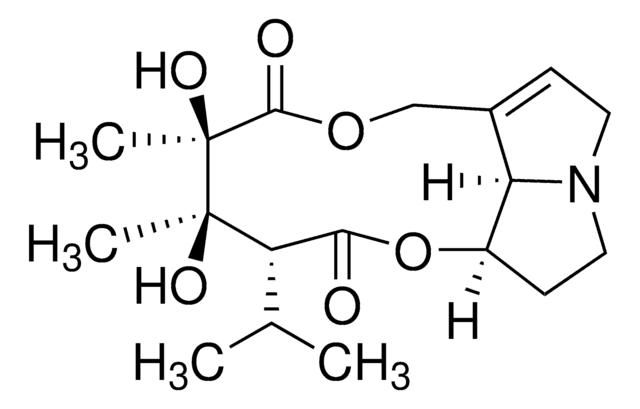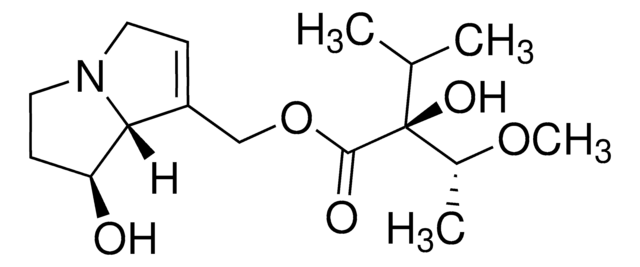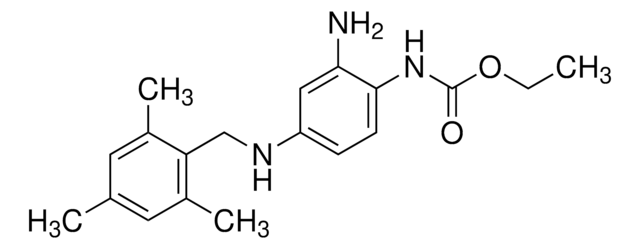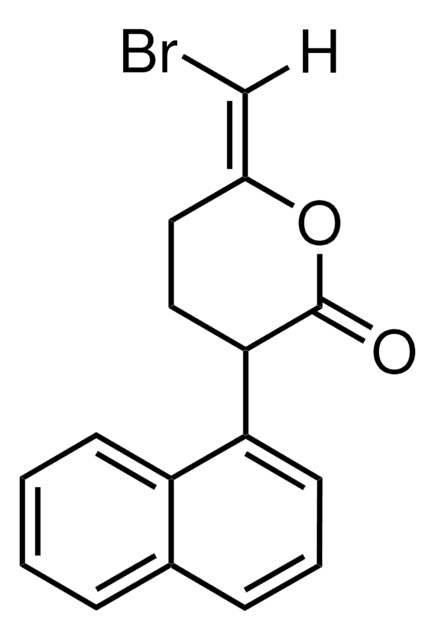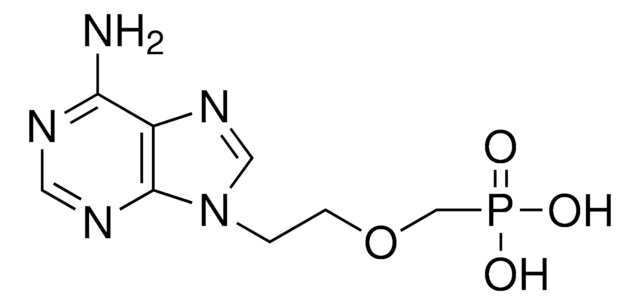추천 제품
제품명
Aristolochic acid I, powder
분석
≥90% (HPLC)
양식
powder
색상
yellow
mp
269-270 °C
solubility
DMSO: soluble
ethanol: soluble
저장 온도
2-8°C
SMILES string
COc1cccc2c1cc([N+]([O-])=O)c3c(cc4OCOc4c23)C(O)=O
InChI
1S/C17H11NO7/c1-23-12-4-2-3-8-9(12)5-11(18(21)22)14-10(17(19)20)6-13-16(15(8)14)25-7-24-13/h2-6H,7H2,1H3,(H,19,20)
InChI key
BBFQZRXNYIEMAW-UHFFFAOYSA-N
유사한 제품을 찾으십니까? 방문 제품 비교 안내
일반 설명
Aristolochic acid is a naturally occurring plant metabolite found in Aristolochia sp, Bragantia sp. or Asarum sp. plants. It comprises a mixture of nitrophenanthrene carboxylic acids such as aristolochic acid I and II.
애플리케이션
Aristolochic acid I have been used:
- as a standard for the analysis of Aristolochia sprucei crude extract by high-performance liquid chromatography
- to study its effects on histone deacetylase 3 (HDAC3) aberration and renal fibrosis
- to induce acute aristolochic acid nephropathy and to study its impact on miRNA and mRNA expression in mice
생화학적/생리학적 작용
Aristolochic acid is a potent inhibitor of phospholipase A2 (PLA2), hyaluronidase, and acetylcholinesterase plasma proteases from snake venoms. Aristolochic acid is considered a herbal medicine and shows therapeutic effects against obstetrics, snake bites, gout, and rheumatism. It exhibits anti-inflammatory and anti-malarial properties. In addition, it is also considered a genotoxic mutagen and causes aristolochic acid nephropathy (AAN), characterized by interstitial fibrosis and urothelial cancer.
Potent phospholipase A2 inhibitor, including calcium ionophore-induced phospholipase A2 activity in neutrophils. Kidney tumor initiator in experimental animal model.
신호어
Danger
유해 및 위험 성명서
Hazard Classifications
Acute Tox. 3 Oral - Carc. 1A - Muta. 1B
Storage Class Code
6.1C - Combustible acute toxic Cat.3 / toxic compounds or compounds which causing chronic effects
WGK
WGK 3
Flash Point (°F)
Not applicable
Flash Point (°C)
Not applicable
개인 보호 장비
Eyeshields, Faceshields, Gloves, type P2 (EN 143) respirator cartridges
이미 열람한 고객
Chung-Hsin Chen et al.
International journal of cancer, 133(1), 14-20 (2013-01-08)
Aristolochic acid (AA), a component of all Aristolochia-based herbal medicines, is a potent nephrotoxin and human carcinogen associated with upper urinary tract urothelial carcinoma (UUC). To investigate the clinical and pathological characteristics of AA-induced UUC, this study included 152 UUC
Guang-Xing Shui et al.
Evidence-based complementary and alternative medicine : eCAM, 2017, 9536458-9536458 (2017-04-20)
Objectives. The effects of the traditional formula Dahuang Fuzi Decoction (DFD) on chronic aristolochic acid nephropathy (AAN) in mice and its underlying mechanisms were studied. Methods. Mice were randomly divided into the following six groups: the control group, the model
Xiao Y Dai et al.
Oncotarget, 7(10), 10841-10856 (2016-02-26)
Aristolochic acid nephropathy (AAN) is a progressive kidney disease caused by some Chinese herbal medicines, but treatment remains ineffective. Macrophage accumulation is an early feature in human and experimental AAN; however, the role of macrophages in chronic AAN is unknown.
Hong Lu et al.
Mediators of inflammation, 2016, 2174682-2174682 (2016-06-18)
Background. Macrophage migration inhibitory factor (MIF) is an important immunoregulatory cytokine involved in inflammation, which may be one important reason resulting in matrix deposition in renal tissues after injury. However, the underlying mechanisms have not yet been elucidated. Methods and
Jie Wei et al.
Journal of chromatography. A, 1246, 129-136 (2012-04-10)
A novel silica-based reversed-phase/strong anion-exchange mixed-mode stationary phase named C18SAX was synthesized based on the polar-copolymerized approach. C18SAX stationary phase showed excellent compatibility with 100% aqueous mobile phase and comparable performance with commercial SunFire™ C18 column in terms of column
관련 콘텐츠
Discover Bioactive Small Molecules for Lipid Signaling Research
자사의 과학자팀은 생명 과학, 재료 과학, 화학 합성, 크로마토그래피, 분석 및 기타 많은 영역을 포함한 모든 과학 분야에 경험이 있습니다..
고객지원팀으로 연락바랍니다.